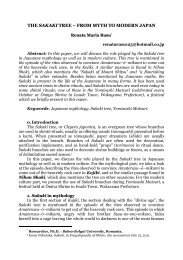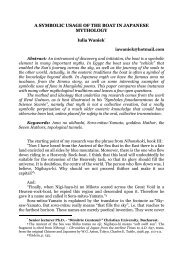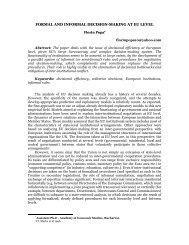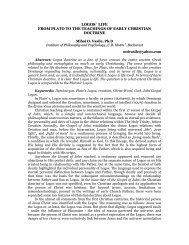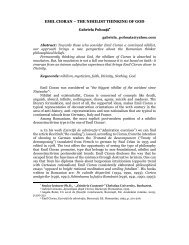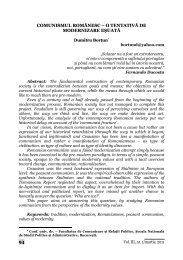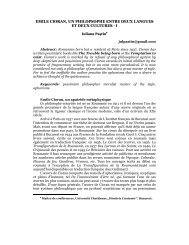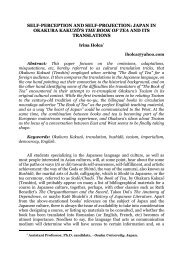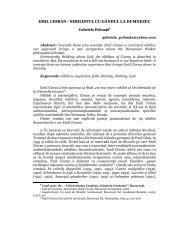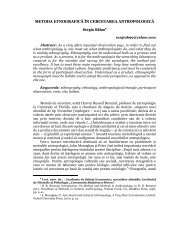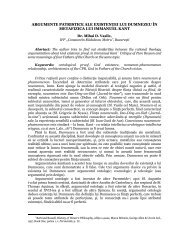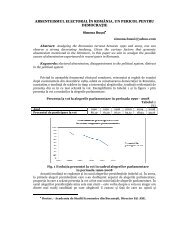JAPANESE TRADITIONAL RAIMENT IN THE CONTEXT OF ... - cogito
JAPANESE TRADITIONAL RAIMENT IN THE CONTEXT OF ... - cogito
JAPANESE TRADITIONAL RAIMENT IN THE CONTEXT OF ... - cogito
Create successful ePaper yourself
Turn your PDF publications into a flip-book with our unique Google optimized e-Paper software.
<strong>JAPANESE</strong> <strong>TRADITIONAL</strong> <strong>RAIMENT</strong> <strong>IN</strong> <strong>THE</strong> <strong>CONTEXT</strong> <strong>OF</strong><br />
EMERGENT CULTURAL PARADIGMS<br />
Svitlana Rybalko ∗<br />
kornev-home@rambler.ru<br />
Abstract: The last decade or so has witnessed a quest for a universal<br />
model to suggest an integral conception of Japanese culture, its reigning<br />
stereotypes and underlying principles. One possible approach or model could be<br />
a study into Japanese raiment, which per se reflects shifts in cultural paradigms<br />
as changes to the costume itself, mode of wearing, its meaning and role, had<br />
been necessitated by changes in cultural values, perception of the meaning of life<br />
and one’s aims in life, as well as lifestyles, aesthetics and zeitgeist.<br />
Keywords: Japanese raiment, cultural paradigm, tradition, modernization.<br />
Modern research into Japanese traditional raiment tends towards a<br />
chronological treatment to the subject. This includes general surveys of the<br />
evolution of the costume as a whole, as well as that of separate garments and<br />
costume sets; studies into the development of weaving and dyeing techniques etc.<br />
Given the vast scope of literary sources, for the purposes of this study we shall<br />
limit ourselves to mentioning but the latest publications which include<br />
comprehensive works by Ando Hiroko 1 , Kirihata Ken 2 , Maruyama Nobuhiko 3 ,<br />
Iwao Nagasaki 4 , Noma Seiroku 5 , Frances Blakemore 6 , Alan Kennedy 7 , Hugo<br />
Münsterberg 8 et al. Alongside fundamental narratives in the history of the<br />
costume there have also appeared systemic studies with a regional focus, which<br />
combine Art History, ethnographic and culturological approaches to review<br />
ethnic peculiarities 9 against the background of the evolution of the mainstream<br />
∗ Professor, Ph.D, - Department of Cultural Studies, Kharkiv State Academy of<br />
Culture.<br />
1<br />
安 藤 宏 子 「 日 本 の 絞 り」 京 都 一 九 九 三 年 九 六 頁 。(Ando Hiroko. Japanese shibori. Kyoto,<br />
1993).<br />
2<br />
切 畑 健 「 歌 舞 伎 衣 装 」 京 都 一 九 九 四 年 九 六 頁 。(Kirihata Ken. Kabuki costume.<br />
Kyoto, 1994).<br />
3<br />
丸 山 信 彦 「 友 禅 染 」 京 都 一 九 九 三 年 九 六 頁 。(Maruyama Nobuhiko. Yuzen dyeing. Kyoto,<br />
1993).<br />
4<br />
長 崎 巌 「 小 袖 」 京 都 一 九 九 三 年 九 六 頁 。(Nagasaki Iwao. Kosode. Kyoto, 1993);<br />
長 崎 巌 「 振 袖 」 京 都 一 九 九 三 年 九 六 頁 。(Nagasaki Iwao. Furisode. Kyoto, 1993).<br />
5<br />
Noma, Seiroku. Japanese Costume and Textile Arts. New York, 1977.<br />
6<br />
Blakemore, F. Japanese Design Through Textile Patterns. New York & Tokyo, 1978.<br />
7<br />
Kennedy, A. Japanese Costume : History and Tradition. Paris, 1990.<br />
8<br />
Münsterberg, H. The Japanese Kimono. Hong Kong, 1986.<br />
9<br />
Mochinaga Brandon Reiko. Textile Art of Okinawa: Collection of Okinawa. Honolulu, 2004.<br />
P. 3-46; Textile Designs of Japan: Volume III Okinawan, Ainu, and Foreign DesignsJapan. Textile<br />
Colour Design Center. Tokyo, 1980.
Japanese textile traditions 1 0 . A number of works are intended to cover the<br />
ornamental diversity of the Japanese costume including the compelling study by<br />
Iwao Nagasaki 1 1 . A special tribute should be paid to the American ethnographer<br />
Liza Dalby whose involved studies have seen a number of editions 1 2 .<br />
Another significant corpus of subject literature includes catalogues of<br />
permanent and itinerary exhibitions and collections of the Japanese costume on<br />
display in various museums worldwide 1 3 . Detailed annotations to the latest<br />
editions as well as a growing number of the costume exhibitions testify for the<br />
broad interest in the kimono both in Japan and beyond 1 4 . Much of our kimono<br />
knowledge is owed to the copyright and brand name holders of the now extinct<br />
large kimono shops as well as reference books and manuals on the types of the<br />
traditional raiment and dressing instructions 1 5 .<br />
The factual materials, however numerous, do not offer an explanation as to<br />
why and how the Japanese costume has evolved the way it has, what were the<br />
driving forces behind its evolution and what are the underlying factors behind its<br />
survival in a much globalized environment. The subject matter of this study is,<br />
therefore, the Japanese traditional raiment in the context of emergent cultural<br />
paradigms.<br />
Such endeavor requires an interdisciplinary approach which necessitates the<br />
application of art analysis, culturological and comparative methods, and involves<br />
diversified sources, among them collections of the Japanese traditional costume,<br />
visual art objects containing ‘costume message’ from state and private museum<br />
collections in Japan, Europe and the USA; literary sources, field study materials<br />
and the researcher’s interviews taken in Japan in 2005-2011 years, as well as<br />
private photographic archives.<br />
І. Costume in Pre-Meiji Japan<br />
І.1. The Evolution of the Traditional Costume: the Natural Body vs<br />
the Social Body. Let us consider, then, the kimono in the diachronic context of<br />
the Japanese culture. As was the case in other cultures, clothing as an ‘exterior<br />
envelopment’ of the body reflects the conception of the bodily and bodily<br />
10<br />
切 畑 健 、 藤 本 恵 子 、 泉 要 次 郎 「 京 の 優 雅 」 京 都 二 〇 〇 五 年 二 四 九 頁 。(Kirihata Ken, Fuji<br />
moto Keiko, Izumi Yodzhiro. The elegance of Kyoto. Kyoto, 2005).<br />
11<br />
. 長 崎 巌 「 着 物 と 模 様 : 日 本 の 形 と 色 」 東 京 一 九 九 九 年 三 三 三 頁 。 (Nagasaki Іwao. Kimono<br />
and patterns (Japanese form and color. Tokyo, 1999).<br />
12<br />
Dalby, L. Kimono: Fashioning Culture. Seattle, 1993.; Dalby, L. Geisha. University of<br />
California Press, 2008.<br />
13<br />
Восток: Искусство быта и Бытия / Государственный Музей Востока. Каталог .<br />
Москва, 2003. (East: The Art of Being and Life. National Museum of the East. Catalogue. Moscow,<br />
2003); Jackson, A. Japanese Textiles in the Victoria and Albert Museum. London, 2000; Fujisawa<br />
Noryo, E. Sano, Y.Woodson, Kawakami Shigeki. Four Centuries of Fashion : Classical Kimono<br />
from the Kyoto National Museum. San Francisco, 1997.<br />
14<br />
Kubota, Itchiku. Opulence: The Kimonos and Robes of Itchiku Kubota. Tokyo, Kodansha<br />
International, 1984.<br />
15<br />
Motoko Ito, Aiko Inoue. Kimono. Higashiosaka, Hoikusha, 1998;<br />
樋 口 清 之 「 装 いの 文 化 」 東 京 一 九 七 三 年 一 二 二 頁 。(Higuchi Kiyoyuki. The culture of the<br />
dressing. Tokyo, 1973); Yamanaka, Norio. The book of kimono. Tokyo etc., 1986. P. 31-131).
practices, yet with a reservation for a hidden paradox. On the one hand, the<br />
bodily (or nudity) was not a taboo per se, which can be explained through the<br />
Shinto cult of nature and the natural. Suffice to recall the first mention of ‘nudity’<br />
in Shinto cosmology, which was attributed to Ame-no Uzume, who resorted to it<br />
in order to bring back the celestial light embodied by the goddess Amaterasu.<br />
On the other hand, the story of Ame-no Uzume’s nudity tends to disappear in<br />
later interpretations of the myth, which testifies for the shift in moral norms.<br />
Indeed, the spread of Confucianism with its hierarchical model of the world order<br />
and sanctified ritual piousness precluded manifestations of what could be defined<br />
as ‘orgiastic’. Thus, the costume was meant to conceal what is natural and<br />
emphasize what is socially-acceptable and meaningful.<br />
It ought to be emphasized that a certain ‘closedness’ in raiment was intrinsic<br />
not only to Japanese culture but also that of China and Korea, whose example<br />
Japan followed for a long time. Significantly, all over the Far East, and in Japan<br />
in particular, the amount of textile used for the garment denoted the social status<br />
of the wearer rather than performed protective function. In other words, the<br />
higher the status, the less was open to other people’s eyes. In as early as the Nara<br />
period (710 - 794), notable for Japan’s close cultural liaisons with China and<br />
Korea, one could not fail to notice social segregation in clothing not only in<br />
compliance the Chinese dress-code with its strict regimentation of the colour<br />
scheme and textile quality but also with the ‘concealed/open’ principle. Noble<br />
ladies clad themselves into long (more than full-length) robes, with sleeves wide<br />
enough to hide the fingertips. More than that, the right way to touch things was<br />
with a hand wrapped in the hem of the sleeve. The ladies of the highest rank<br />
would hold semitransparent fans to shield their faces from inquiring looks. The<br />
Emperor, with his sacred status, would commonly grant audiences in the throne<br />
hall, sitting behind a screen and announcing his will in whisper, which was then<br />
announced by a herald. In the rare moments, as the emperor would make an<br />
appearance from behind the screen, the court ladies formed the passage for him<br />
by crisscrossing their fans on long handles to produce a screen of sorts for no one<br />
to see his face.<br />
The further transformation of raiment into the well-known Heian jūnihitoe<br />
(794-1185), “12-layer robe”, was a logical continuation of the ‘hidden bodily’<br />
concept, resulting from the dual status of clothing as the wearer’s protection from<br />
the evil spirits and outward manifestation of a social rank. Conversely, the lower<br />
the rank, the lower seemed the level of the body’s protection. The lowest rank was<br />
commonly allotted to those in physical labour. Their semi-naked bodies ‘signaled’<br />
for both hard work and low-ranked social marker.<br />
Thus, it transpired, the perfect beauty was only what was… concealed – the<br />
principle deeply embedded into the Japanese culture, the ‘concealed/open’<br />
dichotomy acquiring stable connotations as ‘positive/negative’. But it was not just<br />
the body that was supposed to be concealed in social interaction. The thoughts<br />
were also to be wrapped in the ‘festive clothing’ of the courteous phrases, as well<br />
as presents had to be gift-wrapped prior to the delivery.<br />
Another manifestation of the denial of the body’s natural beauty was the<br />
wide-spread tradition of tattooing, applied for ‘protective’, ritual or penitentiary
easons 1 6 . As was noted, the Edo period (1603—1868) witnessed a tattoo boom<br />
with people from lower walks of life. Those included craftsmen, as well as firefighters<br />
and city guards, who, on the one hand, were not allowed to wear a costly<br />
array and, on the other hand, were often left with no choice other than perform<br />
their duties in their ‘birthday suit’, so to say. For its heyday the practice of<br />
tattooing, however, owed much to the publication of the Japanese translation of<br />
the Chinese novel Simpen Suykogaden (“The River Sloughs”) illustrated by<br />
Katsushika Hokusai (1760 – 1849) and Utagawa Kuniyoshi (1797 – 1862),<br />
featuring the characters as wearing most exquisite tattoos 1 7 . By their artistic<br />
merits, the body paintings could compete with the best textile patterns, at the<br />
same time giving the naked body a ‘clad’ look.<br />
The build-up of the national culture brought forth new behavioral<br />
stereotypes, which, in turn, dictated new approaches to the costume’s volume and<br />
silhouette. The sprawl of Zen practices, as well as Bushido samurai ethic norms,<br />
with its cult of a highly disciplined, loyal and courteous man of a special mould,<br />
necessitated a new dress-code, whereby the multi-layer, loosely-descending<br />
drapes yielded to a strict silhouette, the effect achieved through enveloping a<br />
kimono around the torso. The hectic pace of living in the Meiji (1867-1912) and<br />
Taisho (1912-1926) periods completed the development of a new dress-code,<br />
whose final touch seemed to be the costume’s ‘closed ness’ which answered the<br />
‘bow low’ etiquette completely.<br />
The transition from the free silhouette costume to the tightly fitting<br />
envelopment did not transfigure it into the ‘another perfect body’, as was the case<br />
in Europe. The Japanese did not deem necessary to emphasize certain parts of<br />
the body or to shape the perfect figure. If in Europe, the cut, folds, darts, carcass,<br />
corsette, and/or decolette and other contrivances served to build up an illusion of<br />
the wearer’s body looking perfect to the then beauty standards, Japan went its<br />
own path. The kimono cut still retained the traditional feature of two pieces of<br />
cloth sewn together at the right angle, which, together with the make-up<br />
‘dampened’ not only the age differences, but individual physique as well, whereby<br />
the role of the body was reduced to that of a moving ‘mannequin’.<br />
Lack of interest in the bodily per se is well documented in Japanese visual<br />
arts, which knew of no nude models; nor did it glorify the beauty of the body to<br />
produce an image like that of Venus in European arts. The Japanese artistic<br />
experience is reflected in the perception of clothing not as a means of ‘shaping’<br />
the body, but of enwrapping it.<br />
To sum up, the costume in Japanese culture was intended to emphasize the<br />
wearer’s social status at the expense of ‘degrading’ the natural body. This was<br />
achieved through the application of the strict dress-code, whose idea was<br />
borrowed from ancient China, which regimented the colour scheme, shades, type<br />
and quality of the fabric – all determined by the wearer’s position and social rank.<br />
16<br />
Kitamura, Takahiro. Tattooing from Japan to the West. PA, 2004; Gulik, W. R. Van.<br />
Irezumi. Leiden, 1982.<br />
17<br />
Успенский М.В. Из истории японского искусства. Спб., Гос.Эрмитаж, 2004.<br />
(Uspensky MV. From the history of Japanese art. St. Petersburg., Gos.Ermitazh, 2004).
І.2. Medieval Japan: Traditional Raiment as a Quintessence of<br />
Artistic Experience. The minimalism of the interior of a Japanese housing<br />
reflected in the perception of the kimono as a costly and valuable item. When<br />
hung on a special stand the kimono was intended to serve as a changeable screen<br />
thus integrated in the interior décor. Similarly, the interconnectedness between<br />
architecture and the kimono could be traced down on the example of urban<br />
motifs in raiment adornment, The Sights of Kyoto, The Sights of Osaka, and The<br />
Sights of Nagasaki among them. Note worthily, such kimonos featured concrete<br />
known edifices, rather than imaginary architectural motifs.<br />
The political isolation during the Tokugawa shogunate accounts for almost a<br />
250-year long autochthonous evolutionary period in Japanese culture, which was<br />
marked by what could be described as ‘interosculation of arts’, with existing<br />
techniques being honed and projected onto other arts. In particular, the kimono,<br />
combining two pieces of material stitched together at a right angle, allowed for<br />
almost infinite room for experimenting with motifs and techniques from other<br />
arts. Noma Seiroku, who seems to have been the first to point out the<br />
phenomenon, studied a variety of common motifs used in traditional painting,<br />
lacquer techniques and in costume patterns 1 8 . However, the connection between<br />
traditional raiment and other arts is much deeper. Thus, the kimono ornaments<br />
of the Edo period widely capitulated on such genres as ‘mountain-and-water’,<br />
‘birds-and-flowers’, all these being decorative elements more common to shoji<br />
screens. On the other hand, the kimono had a reciprocal influence on the<br />
contemporary pictorial genres, resulting, in particular, in an emergence of<br />
tagasode-byobu, i.e., screens with the motif of kimono on hanging racks.<br />
Alongside the proven floral motifs, the kimono artists began to resort to<br />
incorporating a hieroglyphic script into the pattern, thus making a textual<br />
reference to an old legend or tale, a historical novel or a No theatre performance.<br />
In this case the hieroglyphic script not only enhanced the visual message, but also<br />
rendered the kimono’s décor into an intellectual puzzle awaiting solution. A<br />
special challenge in this technique lay in the aesthetic calligraphy, which can be<br />
explained through the special status of calligraphy in Japanese visual arts. Iwao<br />
Nagasaki’s explanation of the phenomenon links it to the long-lasting peace in the<br />
Edo period, which ‘whetted the taste’ for belles letters, theatre, and calligraphy<br />
among the then urban population 1 9 .<br />
The advent of xylography accounted for the growing popularity of certain<br />
motifs with city-dwellers. Prevailing in textile patterns became ‘direct quotations’<br />
from the well-known etchings and ever-developing enhancement of patterns. For<br />
example, the best series of bijinga (‘pictures of beautiful women’), a principal<br />
genre in Japanese printmaking, with its sophisticated patterns was a source of<br />
inspiration for textile manufacturers. Interestingly, some of bijinga prints served<br />
as advertising for the ready-made textiles. Such was, for example, the series of<br />
prints, “Summer Clothing. Modern Beauties”, by the renowned bijinga master<br />
Kitagawa Utamaro (ca. 1753 – 1806), published, in 1804-1806, by the Izumi-ya<br />
18<br />
Noma Seiroku. op.cit.<br />
19<br />
Nagasaki Iwao 1999. op.cit.
Publishing House. It was a common practice as it set a stamp on the emergence of<br />
a stereotype composition as envisioning a back view of the beauty to secure a<br />
better display of the kimono ornament. In this connection, Yamada Tokubee finds<br />
the vue arrier in Hishikawa Moronobu’s (1618 – 1694) etchings fairly<br />
understandable, as the artist came from a family owning a textile shop and the<br />
idea of how to show a kimono in the best possible light came naturally to him 2 0 .<br />
ІІ. The Traditional Costume in the Time of Modernization: Sea<br />
Change in Paradigms<br />
ІІ. 1. Rejection and Rehabilitation. The acquisition of the values of the<br />
Western civilization during Meiji and Taisho periods put the issue of the national<br />
identity into question anew. The dialogue with the West gave an impetus to<br />
reevaluation of the own cultural heritage, clothing included. The period was<br />
marked by the quest for balanced solutions, formalization and canonization of a<br />
new dress code.<br />
Whereas at the ‘dawn’ of the Meiji reforms the European clothing was hailed<br />
as synonymous to progress, the early XX century witnessed a sea-change in the<br />
attitudes, whereby the traditional Japanese clothing was no longer regarded as a<br />
sign of provinciality. The rapid transformation of the Japanese society with a<br />
concurrent industrialization and militarization of the country prompted a new<br />
male image, whose lifestyle was best suited by a European-style formal dress.<br />
Conversely, the image of a female as a keeper of traditional values, a devoted wife<br />
and a wise mother of the family was only enhanced, with the traditional kimono<br />
answering this image to the full extent. Undeniable achievements in the country’s<br />
economy, coupled with victorious wars with China and Russia, caused a tidal<br />
wave in national consciousness. The advertising campaigns of that time made a<br />
wide use of the traditional Japanese clothing against the background of all<br />
possible contrivances of the Western civilization.<br />
ІІ.2. Traditional Costume as Symbol of National Unity. A further<br />
development in the kimono design was closely linked to the idea of a solemn Pan<br />
Asian mission for Japan. Imagery of mighty aircraft, military materiel and<br />
ammunition seemed to best reflect Japan’s speedy transformation from feudal<br />
provinciality to the cutting edge of industrialization worldwide, putting Japan at<br />
the forefront of the Pan Asian resistance to European colonization. That is why<br />
not only men’s, but also women’s clothing was influenced by military motifs at<br />
the beginning of 1930-1940s.<br />
The noticeable resort to the motif of Momotaro, a fairytale hero who<br />
intrepidly fights the demons, served the same purpose, the message being simple<br />
to interpret: a boy is a would-be warrior. Interestingly, the Momotaro imagery<br />
featured widely not only in children’s wear, but female clothing as well.<br />
No less popular in children’s clothing were the images of Yoshitsune (1159-<br />
20<br />
山 田 徳 兵 衛 「 図 説 日 本 人 形 史 」 東 京 二 〇 〇 一 年 二 二 二 頁 。 (Yamada Tokubee. The history<br />
of Japanese dolls in the pictures. Tokyo, 2001.P. 222 ).
1189) and Benkei (1155-1189), legendary historic figures. Curiously, some<br />
contemporary designers placed the heroes of Japanese antiquity – clad in<br />
medieval armour and armed with ancient swords – into the modern<br />
environment, i.e. under the Navy’s colours and against the background of aircraft,<br />
men of war, and falling bombs.<br />
The warfare called for an ideological backup. Apart from fairytale and<br />
legendary heroes, the military wanted those in flesh and blood to serve as rolemodels.<br />
Before long, the heroes were found in the person of three private<br />
engineers of the 84 th regiment, Takeji Eshita (1910-1932), Inosuke Sakue (1910-<br />
1932) and Yuzuru Kitagawa (1910-1932). During the battle of Shanghai in 1932<br />
they perished while trying to blow up enemy barbed wire field, blowing up 34<br />
enemy soldiers and opening the venue of approach for the friendly troops. The<br />
deed has been subject to discussion and the rumor has it, that there might have<br />
been accidental deaths of soldiers, who wrongly used the demolition device.<br />
However, what is important is that the propaganda exploited the death of the<br />
soldiers to picture them as folk heroes to go down in Japan’s history. The incident<br />
(with the heroic death in the end) reflected in the motif of the “three soldiers”<br />
who made their way into history as the subject of songs, radio plays, cartoons,<br />
movies and stage plays. Naturally, the imagery was also made use of in the<br />
kimono design, featuring in everything from jubans to women’s sashes and<br />
dresses.<br />
Female clothing was favored by the designers to carry the patriotic message.<br />
The classical imagery of the sakura in blossom and Mount Fuji were readily<br />
complimented with the state and military colors. Certain lines from the state<br />
anthem, kimigayo, produced the necessary décor when combined with a<br />
chrysanthemum ornament, the combination easily interpreted as follows: the<br />
lines of the state anthem convey the message of praise of and faith to the<br />
Emperor, whereas the chrysanthemum symbolized the mon (coat of arms) of the<br />
Royal House. It would not be an exaggeration to note, that the national colors, or<br />
their symbolic representation, hinomaru fans were the most popular motif in the<br />
period from the first Sino-Japanese war to the Japan’s loss in the Great Pacific<br />
war.<br />
The economic situation in the country seriously deteriorated towards the<br />
year 1943. It was when the motto ‘Luxury is our enemy’ appeared. Silk clothing<br />
looked inappropriate and the so-called patriotic costume made of baggy pants<br />
and jacket alike came to become the symbol of the nation’s unity.<br />
The following year, Japan found itself in what seemed an economic deadlock.<br />
By 1944, the country’s expenditure exceeded the income four-fold, causing the<br />
state to resort to the ‘severe economy’ measures, throwing all resources into the<br />
military. The high-quality silk then went into the production of parachutes and<br />
wearing a luxury kimono was looked on as bordering on the reluctance to support<br />
the Army. It should come as no surprise that costly kimonos went out of fashion<br />
to yield to austerity, not so much due to inconvenience in the wartime but out of<br />
moral scruples. Yukio Mishima (1925-1970) was precise in describing the<br />
attitudes towards the traditional raiment in times of the war, “There was a young<br />
woman sitting in the room who caught my eye. No surprise, for she was wearing a
luxurious kimono – impossible in the wartime! Any woman who would venture<br />
outdoors in such an improper array would be brought to shame by any passerby<br />
for lack of patriotism and driven back home to change.” 21 Indeed, the<br />
contemporaries reminisced that in the capital the ladies wearing a silken kimono<br />
were warned with a “Luxury-is-our-enemy” card.<br />
All these paved way for new clothing, kokuminfuku (lit. “national uniform”),<br />
envisaging a military-style jacket for men and a narrow-sleeved jacket and a<br />
mompe, a pair of baggy trousers, for women, the pattern taken from the special<br />
clothing of the Edo period, proved convenient in the wartime. From that time on,<br />
many women in Japan still wear a kokuminfuku when doing the home chores.<br />
ІІ.3. Democratization of the Society and a New Dress-code. The<br />
modernization of the country disbanded the social stratification of the Chinese<br />
dress code, with its rigid regimentation of fabrics, colors and contours, which<br />
arrived in Japan on the train of Confucianism. The code allowed for easy<br />
orientation in the ‘senior/junior’ and ‘superior/inferior’ dichotomy. The Meiji<br />
reforms meliorated the existing ranks making all items of clothing equally<br />
accessible to the entire society. Hakama, which initially was aristocratic clothing,<br />
became the official outwear of teachers and students. That is why the Taisho<br />
period reminds the Japanese of a woman in hakama.<br />
However, the disbandment of the outdated social ranking system brought<br />
forth such new concepts as reiso (the appropriate, or polite, clothing) and<br />
kimono-no kaku (level of clothing). The new division classifies all clothing as<br />
reiso or “other than reiso”. Within the reiso, all kimonos fall into discernable<br />
ranks as to the color, kind of pattern and number of coats of arms in the given<br />
family.<br />
The ‘level’ of a kimono must correspond to that of the event it is worn to, as a<br />
kimono per se, in Japanese culture, is one way of establishing tacit rapport and<br />
creating a harmonious atmosphere. As was observed by Yu. M. Lotman, ‘one<br />
feature of fashion is that it is always targeted at a certain addressee: either the<br />
wearer or the beholder 2 2 . The latter is typical of the Japanese approach to<br />
clothing as recognizing the priority of ‘the other’. Therefore, the choice of clothing<br />
is not so much a matter of own preference but a dictate of the society, thus<br />
reflecting the image of one’s ‘self’ in the eyes of the others. As distinct from<br />
Europe, where clothing is a means of manifesting one’s individuality, in Japan it<br />
is a medium of establishing universal harmony.<br />
As markedly distinct is the dress ‘conduct’ of heads of state. Such ‘masters of<br />
the world’ as Napoleon, Hitler, and Stalin practiced emphatic austerity in their<br />
clothing. This meant to symbolize that they were the ones who could afford to<br />
look down on others, or, as Yu. Lotman remarked, ‘the whole world was just a<br />
spectacle for them’ 2 3 . Following the European suit in clothing did not significantly<br />
21<br />
Мисима Юкио. Избранное. Москва, Терра, 1996. Р. 176. (Yukio Mishima. Favourites.<br />
Moscow: Terra, 1996. Р. 176.)<br />
22<br />
Лотман, М.Ю. Непредсказуемые механизмы культуры. Таллин, 2010. Р. 82. (Lotman<br />
Mi.Y. Unpredictable mechanisms of culture. Tallinn, 2010. Р. 82.)<br />
23<br />
Ibid., p.93
change the Japanese approach to it as an important constituent of social conduct,<br />
whereby adhering to the costume etiquette is compulsory for all members of the<br />
community. More than that, initiating changes to traditional dress code, the<br />
Japanese emperors themselves set example for the rest of the country.<br />
ІІ. 4. The Kimono Nowadays: a Spiritual Dimension. In the post-<br />
WWII period the European suit eventually established itself as a formal dress,<br />
while the kimono reserved the status of festive raiment. The author’s survey of<br />
2005-2006 showed that it was the kimono, which was held in highest esteem by<br />
the Japanese as a symbol of contemporary Japanese culture. At the same time,<br />
the transition of the traditional raiment from every day wear to the solely festive<br />
status brought about some certain incompetence, with the ‘third generation’, in<br />
the art of putting on and wearing a kimono. To meet this need, numerous schools<br />
run workshops in the art of putting on and wearing a kimono (kimono kitsuke).<br />
However, another term, sodo (lit. “the way to put on a kimono”) (similar to<br />
sado – tea ceremony, kado – the way of flowers, kodo – the way of Incense etc),<br />
has been gaining in popularity recently. The coinage is often attributed to<br />
Yamanaka Norio (1960s). It is worth mentioning, that all these terms come from<br />
“bushido” ( 武 士 道 , Way of the Warrior-Knight) and appeared after the<br />
Meiji revolution, when the samurai class was abolished. Thus, the development of<br />
the “way” idea can be reviewed as contamination of the military ethics complex,<br />
which has always been the core of the Japanese upbringing.<br />
The perception of the kimono within the above-mentioned context and the<br />
establishment of the notion 'sodo' in the end of XX c. is a logical ending of the<br />
military ethics code transformation within the present ‘cast-free’ and<br />
demilitarized society. It is not hard to discern the military culture remains within<br />
the aesthetics of wearing a kimono, which is aimed not only at the celerity and<br />
rationality of the procedure and neat appearance, but also at achieving full<br />
concentration, or a state which the Japanese call "the spirit alert".<br />
It is worth mentioning that although both kitsuke and sodo could be<br />
understood as “mastery in putting on and wearing a kimono” the latter implies<br />
not only the expertise in combining the right garments in the right way and<br />
putting them on quickly and neatly, but also observing a moral and ethical code<br />
and a way for self-development. The art of sodo has become an integral part of<br />
the kimono culture. Yamanaka Norio (born in 1928) can boast of numerous<br />
think-alikes, and his 'philosophy of clothing' has been developed in the works of<br />
other researchers in the traditional culture. Higuchi Kiyoyuki (1909-1997)<br />
describes sodo as follows. "Putting a kimono on is an act of general human<br />
significance and, before even beginning to study the kimono, one should<br />
comprehend why people wear kimonos in the first place. If it does not develop<br />
you spiritually, you can call it ‘technique’ and nothing else. Firstly, one should<br />
understand what a kimono is about, then – appreciate the beauty of the kimono,<br />
and finally - to begin to view the kimono as a manifestation of one's personal<br />
traits (sodo). We have to wear something, we have to eat and drink, but what if<br />
we could not develop ourselves spiritually, what if we removed the idea of a 'way',<br />
what is the value of a human being then? Dressing warmly in winter? Even
animals do so simply by hiding into their winter dens. It is the spiritual exploits<br />
that differ human beings from animals. They enrich your heart, and, thus, the<br />
society. If there is an idea of a 'way' to everything, even everyday activities, then<br />
there will be eternal peace and a way for development for a country.<br />
To sum up the thoughts on sodo's role in the life of the Japanese, Higuchi<br />
Kiyoyuki determines its social, cultural and humanistic meanings. He writes: "If<br />
one is wearing a kimono, which destroys the balance within society, the society<br />
perceives the person as a lunatic. Dressing up in the same clothes, as the Chinese<br />
do, is also no appropriate for us. The idea of a 'way' cannot exist without<br />
education. The notion ‘sodo’ suggests a way for self-improvement as well as the<br />
melioration of the society we live in.<br />
Thus, at the turn of XX – XXI c.c., the Japanese raiment seemed to<br />
transcend to a spiritual dimension, functioning not only as a means of national<br />
and cultural identity, but also as a way of moral and ethical upbringing. By<br />
changing oneself by way of putting on a kimono, one helps promote the spiritual<br />
in the country, and, hence, in the world 2 4 .<br />
Summing up, it ought to be emphasized, that the evolution of the Japanese<br />
raiment unfailingly reflects the changes in historical-and-cultural paradigms. The<br />
classical period, prior to the Meiji reforms, was thus marked with the Chinese and<br />
Korean influence on philosophy of the costume as a multilayer robe set rejecting<br />
the natural bodily and elevating one’s social status.<br />
The establishment of the Japanese raiment coincided in time with the sprawl<br />
of Zen-Buddhism and Confucianism. The Zen practices, which regimented the<br />
aesthetics of the interior and the ethic code of conduct, could not fail to influence<br />
the emergence of a new type of clothing, namely that enwrapping the body.<br />
The enhancement of the textile techniques and the special significance of the<br />
costume in the society’s perception enabled the projection of the centuries-old<br />
artistic experience onto the raiment decor.<br />
Paradoxically, the rapid modernization of Japan, which seemingly prompted<br />
the rejection of the national costume as synonymous to backwardness, not only<br />
accounted for its later comeback, but also for its 'revamp', both aesthetically and<br />
ethically. On the turn of the XXI century, the Japanese traditional raiment has<br />
come to serve not only as festive clothing, but also as an idiom of cultural<br />
identification and spiritual self-improvement.<br />
REFERENCES<br />
1. Ando, Hiroko. Japanese shibori. Kyoto, 1993<br />
安 藤 宏 子 「 日 本 の 絞 り」 京 都 一 九 九 三 年 九 六 頁 。<br />
2. Blakemore, F., (1978), Japanese Design Through Textile Patterns. New<br />
York & Tokyo.<br />
3. Dalby, L., (1993), Kimono: Fashioning Culture. Seattle.<br />
4. Dalby, L., (2008), Geisha. University of California Press.<br />
5. Fujisawa Noryo, E. Sano, Y.Woodson, Kawakami Shigeki, (1997), Four<br />
24<br />
Norio Yamanaka 2002, op.cit.
Centuries of Fashion: Classical Kimono from the Kyoto National Museum. San<br />
Francisco.<br />
6. Gulik, W. R. Van, (1982), Irezumi. Leiden.<br />
7. Higuchi, Kiyoyuki, (1973), The culture of the dressing, Tokyo,<br />
樋 口 清 之 「 装 いの 文 化 」 東 京 一 九 七 三 年 一 二 二 頁 。<br />
8. Jackson, A., (2000), Japanese Textiles in the Victoria and Albert<br />
Museum. London.<br />
9. Kennedy, A., (1990), Japanese Costume: History and Tradition. Paris.<br />
10. Kirihata, Ken, (1994), Kabuki costume. Kyoto,<br />
切 畑 健 「 歌 舞 伎 衣 装 」 京 都 一 九 九 四 年 九 六 頁 。<br />
11. Kirihata Ken, Fujimoto Keiko, Izumi Yodzhiro. The elegance of Kyoto.<br />
Kyoto, 2005 切 畑 健 、 藤 本 恵 子 、 泉 要 次 郎 「 京 の 優 雅 」 京 都 二 〇 〇 五 年 二 四 九 頁 。<br />
12. Kitamura, Takahiro, (2004), Tattooing from Japan to the West. PA.<br />
13. Kubota, Itchiku, (1984), Opulence: The Kimonos and Robes of Itchiku<br />
Kubota. Tokyo, Kodansha International.<br />
14. Lotman Mi.Y., (2010), Unpredictable mechanisms of culture. Tallinn,<br />
2010 Лотман, М.Ю. Непредсказуемые механизмы культуры. Таллин.<br />
15. Maruyama, Nobuhiko. Yuzen dyeing. Kyoto, 1993<br />
丸 山 信 彦 「 友 禅 染 」 京 都 一 九 九 三 年 九 六 頁 。<br />
16. Yukio Mishima, (1996), Favourites. Moscow, Terra, 1996 Мисима<br />
Юкио. Избранное. Москва, Терра.<br />
17. Mochinaga Brandon Reiko, (2004), Textile Art of Okinawa: Collection of<br />
Okinawa. Honolulu.<br />
18. Motoko Ito, Aiko Inoue, (1998), Kimono. Higashiosaka, Hoikusha.<br />
19. Munsterberg, H., (1986), The Japanese Kimono. Hong Kong.<br />
20. Nagasaki, Іwao. Kimono and patterns (Japanese form and color).<br />
Tokyo, 1999 長 崎 巌 「 着 物 と 模 様 : 日 本 の 形 と 色 」 東 京 一 九 九 九 年 三 三 三 頁 。<br />
21. Nagasaki, Iwao, (1993), Kosode. Kyoto,<br />
長 崎 巌 「 小 袖 」 京 都 一 九 九 三 年 九 六 頁 。<br />
22. Nagasaki Iwao, (1993), Furisode. Kyoto,<br />
長 崎 巌 「 振 袖 」 京 都 一 九 九 三 年 九 六 頁 。<br />
23. Noma, Seiroku, (1977), Japanese Costume and Textile Arts. New York.<br />
24. Textile Designs of Japan: Volume III Okinawan, Ainu, and Foreign<br />
Designs Japan. Textile Colour Design Center. Tokyo, 1980<br />
25. Uspensky MV. From the history of Japanese art. St. Petersburg.:<br />
Gos.Ermitazh, 2004 Успенский М.В. Из истории японского искусства.<br />
Санкт-Петербург, Гос.Эрмитаж,<br />
26. East: The Art of Being and Life. National Museum of the East.<br />
Catalogue. Moscow, 2003 Восток: Искусство быта и Батия.<br />
Государственный Музей Востока. Каталог. Москва, 2003.<br />
27. Yamada, Tokubee. The history of Japanese dolls in the pictures. Tokyo,<br />
2001 山 田 徳 兵 衛 「 図 説 日 本 人 形 史 」 東 京 二 〇 〇 一 年 二 二 二 頁 。<br />
28. Yamanaka, Norio, (1986), The book of kimono. Tokyo etc.<br />
29. Yamanaka, Norio. Sоdо. Tokyo, 2004 山 中 典 士 「 装 道 」 二 〇 〇 四 年 一 四 頁 。<br />
30. Yamanaka, Norio., (1980), Kimono and spiritual culture of Japan.
Tokyo, 山 中 典 士 「 着 物 と 日 本 精 神 文 化 」 東 京 一 九 八 〇 年 一 二 二 頁 。<br />
31. Yamanaka, Norio, (2002), Wisdom of Japan, who do not know<br />
Japanese. Tokyo,<br />
山 中 典 士 「 日 本 人 の 知 らない 日 本 の 叡 智 」 東 京 二 〇 〇 二 年 二 四 五 頁 。




